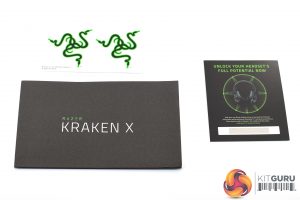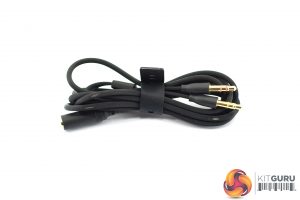The Razer Kraken X ships in a black box, with Razer’s signature green accenting. A large image of the headset itself is visible on the front, while on the back Razer has highlighted several key features of the product.
Opening up the box, we can see that the headset sits within a cardboard frame, with a plastic mould to keep it in place.
We also find a pair of Razer stickers alongside a quick-start guide. The last little leaflet is in fact the license code for the 7.1 virtual surround sound I mentioned on the first page. Owners of both the Kraken X and the new Kraken (2019) get access to this software, and if a license code didn’t come in the box, you can get one by registering your headset on Razer’s website.
Taking a look at the headset itself, it is immediately recognisable as a ‘Razer Kraken’, with very similar design language to other, more expensive headsets we have reviewed in the past. It’s all matte-black – with no colour anywhere on the headset – while the frame and ear cups are all made from plastic.
Speaking of those ear cups, the back of each cup is home to the Razer logo – printed in black, not green – while this area is surrounded by a honeycomb mesh. This may give the impression of an open-back headset, but it is just an aesthetic choice – the Kraken X is still closed-back like most other gaming headsets.
On the inside, we get a look at the leatherette ear cushions. These are now oval-shaped – some readers may remember Razer’s Kraken headsets used to have circular cushions – and I am particularly pleased to see the cushions are removable. This makes them easier to clean or even replace once the memory foam padding has worn down. Lastly, Razer also points out that the cushions have ‘hidden eyewear channels’ which are designed to prevent any discomfort or clamping around the temples if you wear glasses (which I do).
As for the headband, this is primarily made from polycarbonate-ABS – or plastic – with ‘Razer’ branded on the top side of the headband. The inside, however, does have a cushioned section – about 1.5cm thick – where the headset actually makes contact with your head.
One last point on the headband is that its adjustable slider has size markings, from 1 to 9, which become visible as you extend the size of the Kraken X.
Other features to note include the on-ear controls. There’s no in-line remote with the Kraken X, but instead you get a volume wheel and mic mute button on the back of the left earcup.
Then there’s the mic. This isn’t retractable – one of the cost saving measures for the Kraken X – but thankfully it is still very flexible and can be bent up and out of sight when not in use. The microphone itself uses what Razer describes as a ‘cardioid pattern’, designed to pick up sound from the area around your mouth while rejecting sound from the back and sides. We test the mic on the next page.
Lastly, the headset itself features an integrated, non-removable 1.3m cable which is made from a silicon-type material, and as we have mentioned this terminates with a 3.5mm jack. Thankfully, Razer also includes a splitter cable which measures approximately 1.5m long. This provides separate audio and mic jacks for use with a PC.
 KitGuru KitGuru.net – Tech News | Hardware News | Hardware Reviews | IOS | Mobile | Gaming | Graphics Cards
KitGuru KitGuru.net – Tech News | Hardware News | Hardware Reviews | IOS | Mobile | Gaming | Graphics Cards
















